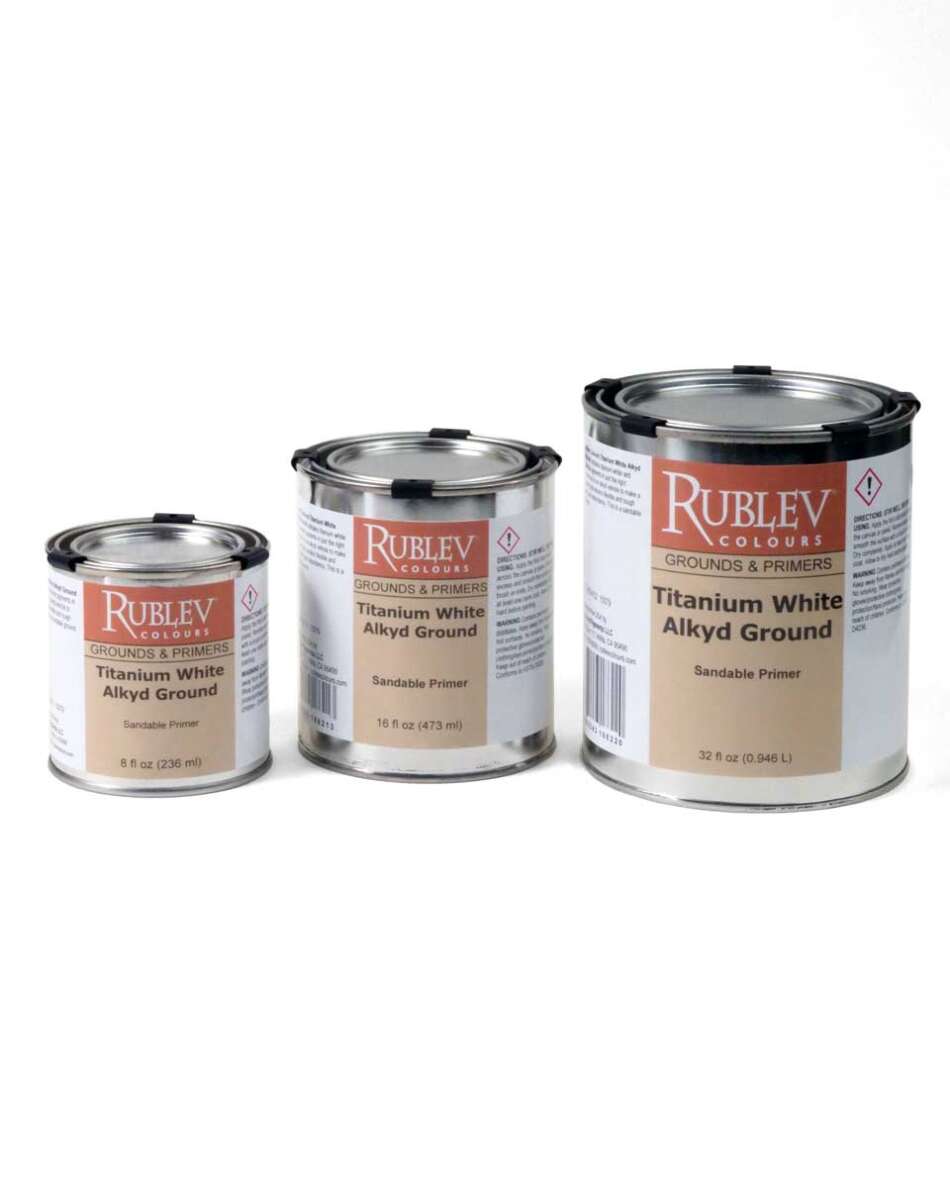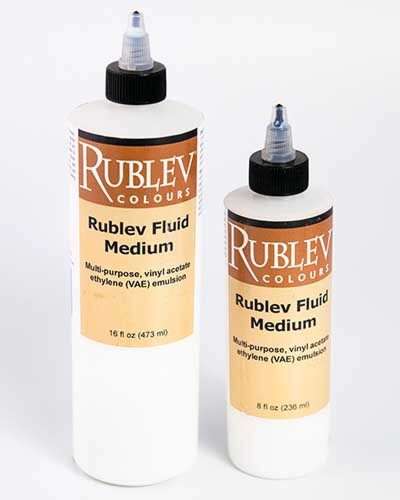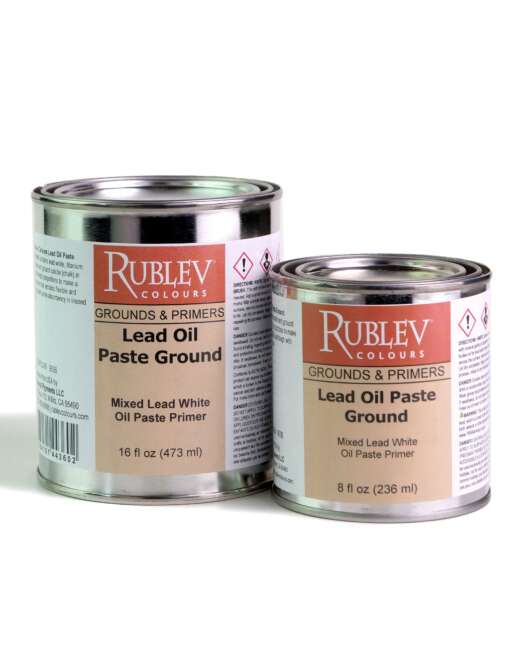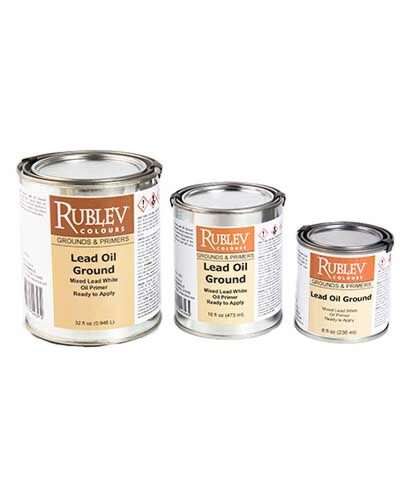In painting, the ground serves the fundamental purpose as a preparatory layer for the support. Its significance lies in its ability to influence the chromatic and tonal values of subsequent paint layers. The ground sets the stage for the painting by providing a stable foundation.
Titanium White Alkyd Ground for Oil Painting - Premium Oil Ground
Rublev Colours Titanium White Alkyd Ground contains titanium white pigment and alkyd for a semi-absorbent ground ideal for oil painting that is sandable for smooth surfaces. It is formulated for coating non-absorbent supports, such as ACM, and absorbent rigid supports, such as hardboard.
Rublev Colours Titanium White Alkyd Ground for Oil and Alkyd Painting — High Pigment Content, Crack Resistant
Rublev Colours Titanium White Alkyd Ground is a blend of white pigments in alkyd for a semi-absorbent ground ideal for oil and alkyd painting. It is formulated for priming non-absorbent rigid supports, such as ACM or copper. Still, it can also be used on absorbent rigid supports, such as solid wood or hardboard, or canvas mounted on rigid supports. While it is best applied to rigid supports, it can be applied to stretched canvas. Rublev Titanium White Alkyd Ground typically dries within eight hours.
Rublev Colours Titanium White Alkyd Ground has a high concentration of pigments, so usually, only two coats are necessary, but more coats create a smoother, less absorbent surface. Apply directly onto ACM or copper panels with the recommended preparation below or onto wood surfaces. Rublev Titanium White Alkyd Ground is an excellent foundation for oil and alkyd paints.
The essential characteristics that grounds should have are (1) adhesion, 2) flexibility, 3) penetration control, 4) a type of surface to which upper layers can adhere well, 5) blister and crack resistance, and 6) good application properties. Careful selection of ingredients in an oil ground is essential to impart these qualities to the ground. Ground natural calcite (calcium carbonate), barite, and wollastonite (all natural minerals), in combination with a maximum chalk-resistant grade of rutile titanium dioxide, have proven to be an excellent choice of pigments in such grounds.
Sandable Primer for Smooth Finishes
Unlike grounds containing lead white, Rublev Colours Titanium White Alkyd Ground can be sanded to a smooth finish to help achieve a uniform surface for oil and alkyd painting. The ground is excellent for smooth fill-in of surface imperfections and is effective on both coated ACM and unpainted wood surfaces.
Formulated for Rigid Supports Like ACM but Flexible Enough for Canvas
Pigments
We make Rublev Titanium White Alkyd Ground with titanium white and two extender pigments—barite, calcite, and wollastonite in just the right proportions to make a flexible, tough film with some absorbency. This blend of pigments gives this ground maximum opacity and a brilliant white surface.
Rublev Titanium White Alkyd Ground pigments have a closely controlled particle size distribution. The grades of barite and calcite are designed to provide the lowest possible oil absorption. The ground offers the desired penetration control with maximum chalk resistance. Barite aids in forming the type of surface on grounds to which upper layers will adhere easily.
Titanium white maximizes the opacity of this ground and provides a brilliant white surface. We have selected a grade of titanium white with good hiding and excellent dispersion properties.
Does Not Contain Zinc Oxide
Many manufacturers use zinc white (zinc oxide) to get a brighter white in their grounds and paint. Zinc oxide is not recommended in oil grounds since it tends to cause blistering and cracking in oil paint and grounds—we have not used any zinc in this product.
Vehicle
After many trials, we have chosen a specific alkyd with limited oil penetration into absorbent substrates to maintain sufficient holdout, establish a good foundation for the upper layers, and ensure good adhesion to non-absorbent substrates. This alkyd provides the best possible leveling properties, minimizing brush and knife marks.
As part of the formula, Rublev Titanium White Alkyd Ground contains mineral spirits to provide the right fluid consistency and to hasten drying.
Driers
A blend of cobalt, zirconium, and calcium driers has been added to ensure rapid drying once it is applied.
Storage
Rublev Titanium White Alkyd Ground contains an anti-skinning agent to prevent skinning and drying in the can during storage. If kept tightly closed, the contents can be expected to last indefinitely, but we recommend purchasing only an amount that can be used within one year.
Directions
STIR WELL BEFORE USING.
Brush Application
Using a bristle brush, apply the first Rublev Titanium White Alkyd Ground coat evenly across the panel's surface. Remove any excess and smooth the surface with a brush or palette knife. Let it dry completely—hard dry. Apply at least one more coat by repeating the process. Allow the panel to dry thoroughly before painting.
Roller Application
Apply with a foam roller (not a nap roller) for an eggshell finish. Foam rollers produce the smoothest finish and are ideal for use on ACM. Apply a thin coat with the foam roller and make it slightly tacky. Smooth the ground with the foam roller without loading more ground.
A plastic scraper can also be used to smooth the ground once it is applied with a brush or roller.
It is unnecessary to dilute Rublev Titanium White Alkyd Ground, but it can be thinned with mineral spirits, odorless mineral spirits (OMS), or turpentine. For best results, do not over-dilute.
Recoating, Drying, and Painting
Apply the ground in thin coats. Do not overload the brush or roller with the ground. Apply at least two coats, but four coats are recommended for best results. Allow each coat to dry overnight and allow it to dry one week after applying the final coat before painting. Actual drying times may be longer in high-humidity and low-temperature environments.
Preparing Aluminum Composite Material (ACM) For Priming
Note: Use only the coated side of the panel for painting and mounting.
• Remove the protective film from the coated side slowly and carefully to avoid static build-up.
• Clean the panel surface with denatured ethyl or isopropyl alcohol using a non-colored, lint-free cloth for best results. It is essential not to use solvents, soaps, or liquid cleaning materials as they may leave a film residue that can affect adhesion. Additionally, cleaners containing silicone can interfere with adhesion and are not recommended. A solution of isopropyl or denatured alcohol is recommended as the cleaning material.
• Scuff the surface with abrasive paper, preferably using a grain size of 360 grit. Do not grind through the coating to the aluminum metal.
• Remove dust with a lint-free cloth moistened with denatured or isopropyl alcohol.
• For priming, please follow the directions above.
Hints for Better Priming Results on ACM
• Acclimate the panel to room temperature before use—especially when the panel has been stored at a low temperature.
• Avoid fluctuating humidity and dry environments—this can lead to static build-up.
• Do not touch panel surfaces with bare hands, and do not allow any liquid cleaning materials or solvents (except denatured or isopropyl alcohol) to dry on the panel surface.
• If the panel has a protective film, this should be removed slowly and carefully to avoid static build-up.
• For best results, sweep the panel surface with ionized air before painting or mounting and consistently apply measures to reduce static build-up.
• Do not subject the ACM panel to heat exceeding a maximum of 80° C (175° F).
Preparing Wood For Priming
• Lightly sand the surface with sandpaper or emery paper to a smooth surface before priming.
• Remove wood particles from the surface with a lint-free cloth.
• Follow the directions above for brush or roller application.
Frequently Asked Questions
What is the purpose of a ground in painting?
Do oil paintings require the use of a ground?
Absolutely! The role of the ground in oil painting is paramount. Acting as a protective barrier between the support and the oil painting, it ensures good adhesion between the two elements. Not only does it facilitate proper adhesion of the paint to the substrate, but it also contributes to the stability of the artwork.
What is the difference between an oil ground and alkyd ground in oil painting?
Alkyds are a class of synthetic resins made from vegetable oils or the fatty acids of vegetable oils such as linseed oil. Alkyds used in artists' materials, such as medium and grounds, contain large amounts of vegetable oil and are called long-oil alkyds. The advantage of alkyds over oil is that they typically dry quickly and form harder films. They also offer better adhesion to metal and other non-absorbent surfaces. This is the primary reason we use a long-oil alkyd in Rublev Colours Lead Alkyd Ground, which is specifically formulated for use on aluminum composite material (ACM) panels.
What is the best ground for oil painting?
When it comes to oil painting, the best priming is a lead white ground bound with linseed oil (or alkyd). The advantages are manifold, as this combination imparts unmatched durability, film strength, and flexibility to subsequent oil paint layers. For optimal performance over time, pairing the lead ground with lead white paint is an exceptional choice.
How many coats of oil ground do I need for an oil painting?
For the best outcome on absorbent substrates like wood or sized canvas, applying a minimum of four coats of oil ground is the best practice. As for non-absorbent substrates, such as aluminum composite materials (ACM) panels, Rublev Colours Lead Alkyd Ground is the best choice for adhesion and absorbency.
How long does it usually take for an alkyd ground to dry?
Generally, re-coating is possible the next day with Rublev Colours Lead Alkyd Ground. However, it is advisable to allow at least one week before starting the painting process after applying the last coat.
Can you put an alkyd or oil ground over an existing oil painting?
Under specific circumstances, applying an alkyd or oil ground over an existing oil painting is possible. If the original oil paint is thin and the overall appearance is dull or matte, you may apply a coat of oil ground over the painting. However, caution must be exercised, particularly if the surface is glossy or has a pronounced texture. In that circumstance, we recommend sanding it before applying the oil ground.
Can I apply an oil or alkyd ground over acrylic priming?
The compatibility between an oil or alkyd ground and acrylic primer opens up possibilities for experimentation and versatility. To achieve the best results, ensure that all acrylic materials have fully dried and cured beforehand. The waiting period is typically around three days for thin acrylic films, though thicker applications, such as one-quarter inch or more, may require more time, perhaps as much as two to three weeks. Environmental factors, such as air movement and temperature, also play a role in determining drying time. The acrylic primer or paint must have a matte surface, as oils adhere more effectively to acrylics when applied to matte surfaces because the adhesion of oils to acrylics is mostly mechanical. Before applying the oil ground, always wipe the surface of the acrylic primer or paint with a soft cloth moistened with distilled water to remove surfactants that may migrate to the surface.
What are absorbent grounds for oil painting?
Absorbent grounds soak up some of the oil and solvent in oil paint, aiding faster pigment drying and a matte appearance. While absorbency in the ground is best for oil paint, excessive absorbency results in an undesirable finish, such as sunken in or dull painting passages and uneven sheen.
What is the difference between ground and gesso?
Ground is a general coating for canvas or panel preparation, while gesso is a specific type of ground for a textured, absorbent surface. Gesso is the Italian word for gypsum and historically was used to describe grounds made of gypsum and animal collagen glue and later included chalk grounds. In the late 1960s, this definition was expanded to include acrylic dispersion grounds. To distinguish traditional or historical gesso from acrylic dispersion grounds, they are often called "glue grounds" or "traditional grounds".
Is oil ground better than gesso?
Whether oil ground is better than gesso depends on the artist's preference and desired outcome. Oil ground dries non-absorbent and smooth; glue grounds are more absorbent and textured. Acrylic gesso or grounds are also more absorbent than oil grounds.
What is a cheaper substitute for gesso?
Some sources claim a cheaper substitute for gesso or acrylic grounds is a mix of white glue, water, and white paint, with optional talcum powder or chalk for texture. However, these grounds are not reliable for fine artwork.
What is homemade gesso?
Gesso or glue grounds can be made by mixing animal collagen glue and gypsum, chalk, or other extender pigments.
Can I use white acrylic instead of gesso?
White acrylic paint can be used as a gesso substitute but may not offer the same surface tooth or absorbency.
How do you smooth a canvas without gesso?
Some sources claim to smooth a canvas without acrylic gesso by sanding gently with fine-grit sandpaper and then applying a layer of acrylic medium. However, this is not recommended as a ground for oil painting.
Can I make my own gesso?
Gesso or glue grounds can be made by mixing animal collagen glue and gypsum, chalk, or other extender pigments.
Why do people paint on black gesso or grounds?
Black grounds is used for creating a dark base in artworks, especially beneficial for high-contrast or dark compositions. This is not a best practice for oil painting due to oil paint's property of becoming more transparent with age, resulting in darkening of the painting.
What happens if you paint without gesso?
Painting without gesso can lead to poor paint adhesion, potential canvas damage, and altered paint absorbency and texture.
| SKU | 510-8TAK |
|---|---|
| Brand | Rublev Colours |
| Vendor | Rublev Colours |
| Processing Time | Usually ships the next business day. |
Health and Safety
WARNING! CONTAINS PETROLEUM DISTILLATES. HARMFUL IF SWALLOWED. Avoid ingestion and skin contact. Wear protective clothing and gloves to prevent contact with the skin. Avoid inhaling fumes of mineral spirits. Use with adequate ventilation. Never use near children or pets. Conforms to ASTM D 4236.
![]() WARNING: This product can expose you to chemicals including **Ethylbenzene, **Naphthalene, **Cumene, **Benzene, which is/are known to the State of California to cause cancer, and **Toluene, **n-Hexane, **Benzene, which is/are known to the State of California to cause birth defects or other reproductive harm. For more information go to www.P65Warnings.ca.gov.
WARNING: This product can expose you to chemicals including **Ethylbenzene, **Naphthalene, **Cumene, **Benzene, which is/are known to the State of California to cause cancer, and **Toluene, **n-Hexane, **Benzene, which is/are known to the State of California to cause birth defects or other reproductive harm. For more information go to www.P65Warnings.ca.gov.









